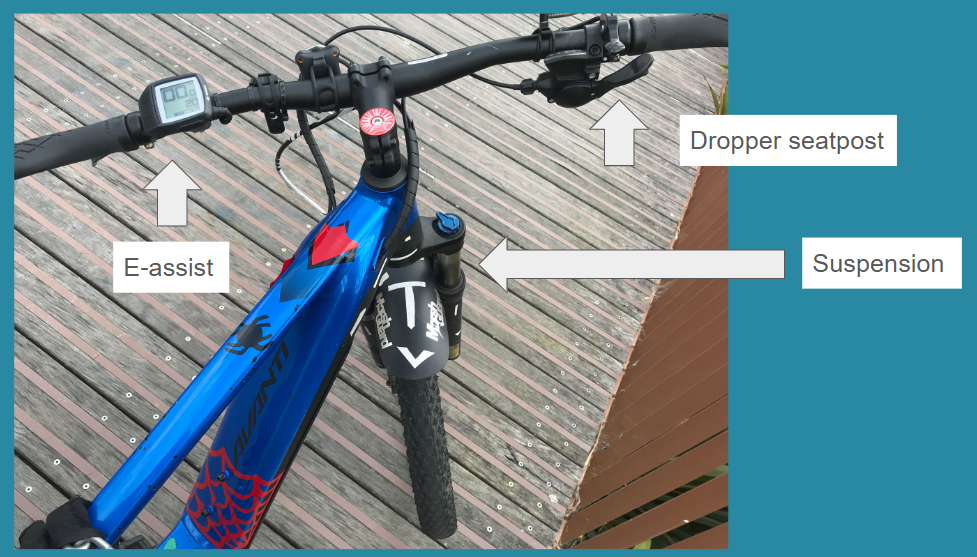“Who wants to cycle next to a motorway anyway?” one of NZTA’s planners once asked me, years ago, when we were discussing future cycleway projects the agency was scoping. “Well,” I thought to myself (but didn’t say out loud), “maybe not that many people, but it’s the only game in town where there’s any money for cycleways at the moment.”
This was in the still-pretty-dark old days, when NZTA had just started putting some money (not much) into cycleway projects, while Council was still treating them as if cycling was a luxury they couldn’t afford –”maybe next year” was still the refrain.
So, sure: cycling next to the motorway wasn’t necessarily anyone’s idea of a relaxing ride, but at least it tends to be direct, and it goes where people want to go, if they are going more than a kilometre or so. But now that we know what we know, when building motorway cycleways, let’s do them right from the start.
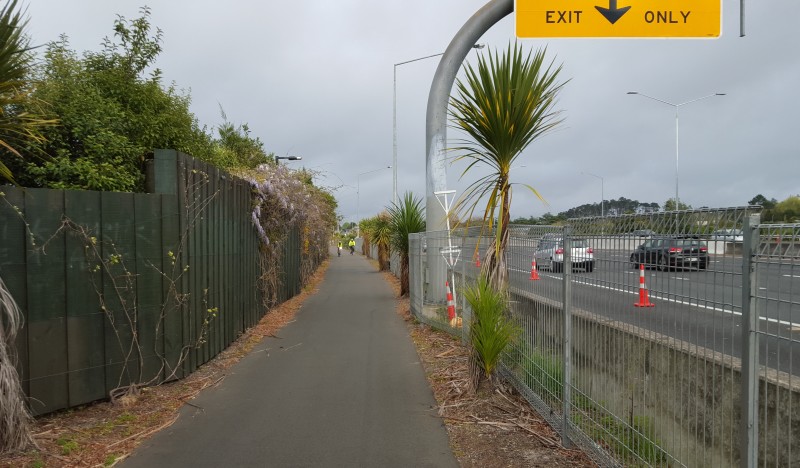
The conversation about “who’d want to bike next to a motorway” dates from when NZTA was busy with the Kingsland section upgrade of the Northwestern Cycleway, adding in a missing piece and thus removing a detour through a hilly part of the suburb. As part of the works, diggers were clearing big swathes of bush along the edge of the motorway… and suddenly, NZTA had lots of local property owners complaining that with the greenery gone, the noise was becoming atrocious.
Now, I studied civil engineering way back in Germany (I even finished it somehow, despite a laid-back attitude to recommended length of study), and I remember learning that on a scientific basis, the idea of “vegetation as noise barrier” is (almost) all bollocks.
Even at 5m deep, thick bush does almost NOTHING as a noise barrier. It’s just… too leafy. Much air, little mass, lots of gaps. Even if light can’t get through it, noise can easily do so. In the village we grew up in, you could sometimes hear the motorway despite several hundred metres of intervening forest.
But there is a real basis to the residents’ complaints: it wasn’t the sound that came through when the Kingsland planting was cleared: it was the light. Suddenly, people could see afresh the motorway that had previously been hidden from their back porches, and the noise that these poor folk were already exposed to daily (and had become accustomed to) became “visible” all over again, and came rushing back into their newly concious ears. The decibel level may not have changed, but the subjective experience of motorway noise stress is very real.
After the complaints got a bit heated, NZTA decided that they’d add noise walls all along the new section of cycleway, even if it made very little change on a measuring dial. So those locals lucked out twice – first, they got a new cycleway past their backyards (with more frequent entrances and exits than any other part of our motorway cycleways – ironically, due to the old inner city street grid that had been broken apart by the motorway in the first place).
And secondly, they got new noise walls, which, even if the sound was only dampened a little, was a real benefit to their home lives, given that constant noise is known to be a major contributor to stress and negative health outcomes.
The interesting thing was how those noise walls were built. About half of them got built with the cycleway between the motorway and the noise wall – and along the other half, the cycleway was visible to the houses, with the noise wall was right up against the motorway breakdown lane.
Unsurprisingly, this has major effects on how it feels to use the cycleway! When you are riding along the sections where you are between the motorway and the noise wall, the grind and churn of our automobile arteries batters you twice – you get the main noise, and then the reflected noise from the barrier itself. Whereas, when you go into the shadow of the walls placed between you and the motorway, you feel some blessed relief.
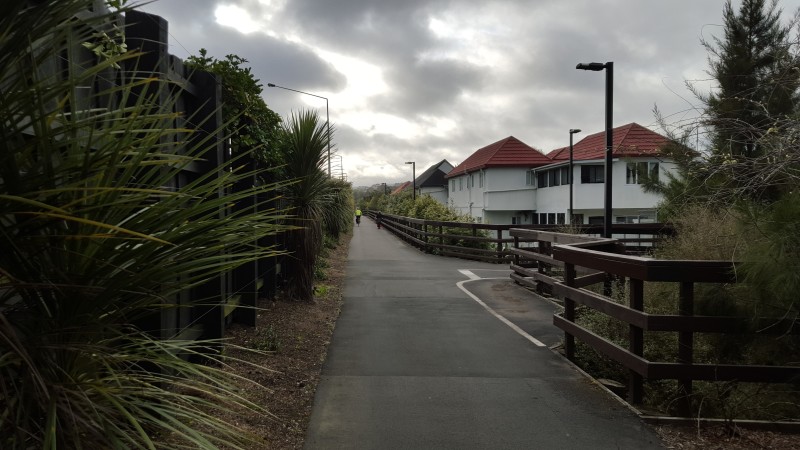
So the decision should be easy for future noise walls along cycleways, shouldn’t it? Just put the cycleway on the “shadow” side of the noise wall, visible and accessible to where people live. Sure, you’ll still be cycling alongside a big barrier, but at least it will be a bit more peaceful. And you can make the wall look pretty, either with plants or with fancy urban design, at which NZTA tends to be pretty good.
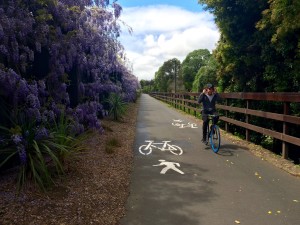
Oh, but wait. We forgot something, it seems.
On pretty much all new motorway cycleways that have been built since, or are being built now (witness the noise walls going in along SH16 near Te Atatu), NZTA keeps putting the noise walls on the property side of the cycleways – leaving cyclists, joggers, and walkers exposed to the motor traffic, both visually and aurally.
When I ask NZTA why can’t path-users have some protection from the noise, I get told that the arrangement is for our own safety and security.
Apparently, when you are being waylaid by highwaymen on the cycleway, or if you trip over while jogging, it’s better to not have an opaque wall between you and the motorway – so people can see you.
Uhmmm, huh? Apart from the fact that in many sections, the cycleway will still be significantly higher or lower than the motorway, those drivers are often rushing by at 80-120 km/h and concentrating on other things than what is happening on the cycleway. (As well they should – after all, they are rushing along steering metal boxes at 80-120 kmh!). And judging by how many people still don’t even know there’s a cycleway along the Northwestern motorway, peripheral vision doesn’t seem a big thing on their radar…
Even if a driver or passenger were to see something happening on the cycleway, they will have normally passed it by in 1-2 seconds. Not quite enough time to decide that something bad has happened, especially if you saw it out of the corner of your eye. And even if something DID happen, and they DID see it, they can’t exactly stop in a hurry. Even if they manage to stop and pull over safely, they would likely have to walk several hundred metres back and then clamber across a high wire fence. No, the best we could hope for is a phone call to the police. And who knows how long that would take to bring help?
So I don’t really buy that as a good reason. Having houses overlook the path seems safer to me – or at least, no more dangerous than having a bike or pedestrian path leading through the middle of a park or a field. When building greenway paths through fields or parks, we might want to design them to keep them relatively free of entrapment spots. But we don’t decide it’s impossible or unsafe to build them just because there aren’t thousands of cars rushing right alongside at great speed!
![Is this section unsafe? It has neither cars nor views of houses. [neither does a track through most parts of a park...]](https://www.bikeauckland.org.nz/wp-content/uploads/2015/10/Unsafe-800x450.jpg)
At first glance, this is an understandable instinct. After all, we tend to have our homes with a public side (on the street) and a private side (away from the street), and many of our lots are long and narrow, meaning that the sides tend to be close to the neighbours. So the backyard becomes the private space. And there may also be some concerns about greater access to the rear of a property leading to more property crimes.
But what if that insistence on retaining a sense of private space by putting cyclists (and pedestrians) on the other side of a big wall actually harms the cycleway users, the residents, AND wider society?
Because as I noted above, a cycleway “shaded” by a noise wall is a much more pleasant place to walk and cycle, and thus will get more use. That will make it safer – and will make the adjacent neighbourhood safer. More people on bikes and on foot, more connectivity and “hello, neighbour” interactions, more eyes on the street able to spot burglars or help out if you have a fall. And also, fewer cars driving though your local streets, which means less noise, less pollution, and less danger to children, pets, and well, everyone.
By contrast, a very noisy path, hidden from houses but exposed to the motorway, a path that makes you hesitate before using it for a stroll or taking the children for a ride or zipping off to school or work – this path will most likely be less well-used by anyone other than commuters travelling motorway-style.
Private properties can still have their privacy and security – nothing prevents homeowners putting high fences and vegetation between the cycleway and their back porches (and vegetation, after all, is much better for protecting against curious peekers than against noise). People might even find that a cycleway along their property is a great way to increase house prices. And maybe NZTA could do a survey of those who live along the Kingsland section of the cycleway, to see how many people feel bugged by having foot and bike traffic running past their back fences, now that it’s settled in for a few years.
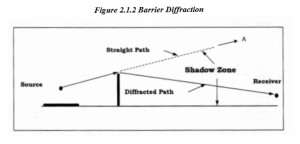
And there are even some direct aural benefits from putting the noise wall closer to the motorway. Because the closer a noise wall is to the actual noise source – the traffic lane, in this case – the more effective it is. Noise is bounced back more towards the middle of the motorway, and more effectively away from houses.
With all those advantages to having the noise wall on the motorway side of our future cycleways, I feel NZTA should be more insistent on doing this right. Unfortunately, on the new cycleways on SH16 coming between Lincoln Road and Westgate, and especially on SH1, between Takanini and Papakura, a lot of “wrong side” noise walls are planned.
Let’s make our motorway-side cycleways more pleasant to use, our motorways more human, and our neighbourhoods embrace their new connecting paths rather than hiding them behind a fence. A worthy challenge for our urban designers to rise up to!




